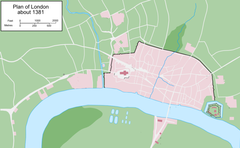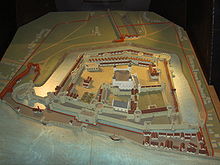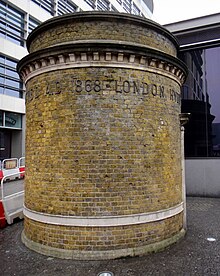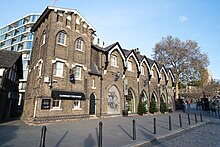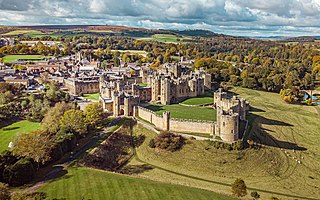
Alnwick Castle is a castle and country house in Alnwick in the English county of Northumberland. It is the seat of the 12th Duke of Northumberland, built following the Norman conquest and renovated and remodelled a number of times. It is a Grade I listed building now the home of Ralph Percy, 12th Duke of Northumberland and his family. In 2016, the castle received over 600,000 visitors per year when combined with adjacent attraction the Alnwick Garden.

William Hastings, 1st Baron Hastings KG was an English nobleman. A loyal follower of the House of York during the Wars of the Roses, he became a close friend and one of the most important courtiers of King Edward IV, whom he served as Lord Chamberlain. At the time of Edward's death he was one of the most powerful and richest men in England. He was executed following accusations of treason by Edward's brother and ultimate successor, Richard III. The date of his death is disputed; early histories give 13 June, which is the traditional date.
John de Vere, 13th Earl of Oxford, the second son of John de Vere, 12th Earl of Oxford, and Elizabeth Howard, a first cousin of John Howard, 1st Duke of Norfolk, was one of the principal Lancastrian commanders during the English Wars of the Roses.

The Lord Steward or Lord Steward of the Household is an official of the Royal Household in England. Holders of the office are always peers, until 1924, were always members of the Government, and until 1782, the office was one of considerable political importance and carried Cabinet rank.

Baron Hastings is a title that has been created three times. The first creation was in the Peerage of England in 1290, and is extant. The second creation was in the Peerage of England in 1299, and became extinct on the death of the first holder in c. 1314. The third creation was in the Peerage of England in 1461, and has been in abeyance since 1960.

Henry Grey, 2nd Duke of Suffolk, 3rd Marquess of Dorset, was an English courtier and nobleman of the Tudor period. He was the father of Lady Jane Grey, known as "the Nine Days' Queen".

Henry Howard, 1st Earl of Northampton was an important English aristocrat and courtier. He was suspected throughout his life of being Roman Catholic, and went through periods of royal disfavour, in which his reputation suffered greatly. He was distinguished for learning, artistic culture and his public charities. He built Northumberland House in London and superintended the construction of the fine house of Audley End. He founded and planned several hospitals. Francis Bacon included three of his sayings in his Apophthegms, and chose him as "the learnedest councillor in the kingdom to present to the king his Advancement of Learning." After his death, it was discovered that he had been involved in the murder of Sir Thomas Overbury.
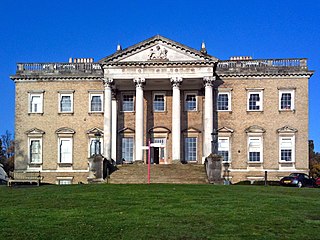
Claremont, also known historically as 'Clermont', is an 18th-century Palladian mansion less than a mile south of the centre of Esher in Surrey, England. The buildings are now occupied by Claremont Fan Court School, and its landscaped gardens are owned and managed by the National Trust. Claremont House is a Grade I listed building.

John Tiptoft, 1st Earl of Worcester KG, was an English nobleman and scholar who served as Lord High Treasurer, Lord High Constable of England and Lord Deputy of Ireland. He was known as "the Butcher of England" to his Tudor detractors.
John de Vere, 12th Earl of Oxford, was the son of Richard de Vere, 11th Earl of Oxford, and his second wife, Alice Sergeaux (1386–1452). A Lancastrian loyalist during the latter part of his life, he was convicted of high treason and executed on Tower Hill on 26 February 1462.
Events from the 1460s in England.
Events from the 1480s in England. This decade marks the beginning of the Tudor period.
Walter Hungerford, 1st Baron Hungerford of Heytesbury, was created Baron Hungerford of Heytesbury in 1536.
Honouring individuals buried in Westminster Abbey has a long tradition. Over 3,300 people are buried or commemorated in the abbey. For much of the abbey's history, most of the people buried there besides monarchs were people with a connection to the church – either ordinary locals or the monks of the abbey itself, who were generally buried without surviving markers. Since the 18th century, it has become a prestigious honour for any British person to be buried or commemorated in the abbey, a practice much boosted by the lavish funeral and monument of Isaac Newton, who died in 1727. By 1900, so many prominent figures were buried in the abbey that the writer William Morris called it a "National Valhalla".

Robert Hungerford, 3rd Baron Hungerford was an English nobleman. He supported the Lancastrian cause in the War of the Roses. In the late 1440s and early 1450s he was a member of successive parliaments. He was a prisoner of the French for much of the 1450s until his mother arranged a payment of a 7,966l ransom. In 1461, after defeat on the Towton battlefield on 29 March, he fled with Henry VI to Scotland. In 1461 he was attainted in Edward IV's first parliament, and executed in Newcastle soon after he was captured at the Battle of Hexham.

Sir Thomas Hungerford of Rowden was an English nobleman. He supported the Lancastrian cause in the War of the Roses and was executed for supporting a conspiracy to restore Henry VI.
Sir Thomas Burgh (; BURRA, KG was an English gentleman.



